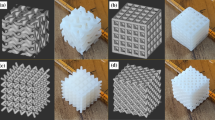Abstract
Hydroxyapatite is a scaffold material widely used in clinical repair of bone defects, but it is difficult for traditional methods to make customized artificial bone implants with complicated shapes. 3D printing biomaterials used as personalized tissue substitutes have the ability to promote and enhance regeneration in areas of defected tissue. The present study aimed at demonstrating the capacity of one 3D printing technique, digital light processing (DLP), to produce HA scaffold. Using HA powder and photopolymer as raw materials, a mixture of HA mass ratio of 30 wt% was prepared by viscosity test. It was used for forming ceramic sample by DLP technology. According to differential scanning calorimetry and thermal gravity analysis, it was revealed that the main temperature range for the decomposition of photopolymer was from 300 to 500 °C. Thus, the two-step sintering process parameters were determined, including sintering temperature range and heating rate. XRD analysis showed that the phase of HA did not change after sintering. SEM results showed that the grain of the sintered ceramic was compact. The compression model was designed by finite element analysis. The mechanical test results showed that the sample had good compression performance. The biological properties of the scaffold were determined by cell culture in vitro. According to the proliferation of cells, it was concluded that the HA scaffold was biocompatible and suitable for cell growth and proliferation. The experimental results show that the DLP technology can be used to form the ceramic scaffold, and the photopolymer in the as-printed sample can be removed by proper high-temperature sintering. The ceramic parts with good compression performance and biocompatibility could be obtained.









Similar content being viewed by others
References
Farag MM et al (2014) Effect of gelatin addition on fabrication of magnesium phosphate-based scaffolds prepared by additive manufacturing system. Mater Lett 132:111–115
Rodriguez G et al (2013) Influence of hydroxyapatite on extruded 3D scaffolds. Procedia Eng 59:263–269
Zein I et al (2002) Fabrication of 3D chitosan–hydroxyapatite scaffolds using a robotic dispensing system. Biomaterials 23:1169–1185
Roh HS et al (2017) Addition of MgO nanoparticles and plasma surface treatment of three-dimensional printed polycaprolactone/hydroxyapatite scaffolds for improving bone regeneration. Mater Sci Eng C-Mater 74:525–535
Wu HD et al (2016) Effect of the particle size and the debinding process on the density of alumina ceramics fabricated by 3D printing based on stereolithography. Ceram Int 42:17290–17294
Slots C (2017) Andersendental, Simple additive manufacturing of an osteoconductive ceramic using suspension melt extrusion. Dent Mater 33:198–208
Bendtsen ST et al (2017) Development of a novel alginate-polyvinyl alcohol-hydroxyapatite hydrogel for 3D bioprinting bone tissue engineered scaffolds. J Biomed Mater Res Part A 105:1457–1468
Jakus AE et al (2017) Multi and mixed 3D-printing of graphene-hydroxyapatite hybrid materials for complex tissue engineering. J Biomed Mater Res Part A 105:274–283
Lee JS et al (2016) Development and analysis of three-dimensional (3D) printed biomimetic ceramic. Int J Precis Eng Manuf 17:1711–1719
Li X et al (2017) Biocompatibility and physicochemical characteristics of poly(ε-caprolactone)/poly(lactide-co-glycolide)/nano-hydroxyapatite composite scaffolds for bone tissue engineering. Mater Design 114:149–160
Tian X et al (2009) Process parameters analysis of direct laser sintering and post treatment of porcelain components using Taguchi’s method. J Eur Ceram Soc 29:1903–1915
Muehler T et al (2015) Slurry-based additive manufacturing of ceramics. Int J Appl Ceram Technol 12:18–25
Yen HC (2015) Experimental studying on development of slurry-layer casting system for additive manufacturing of ceramics. Int J Adv Manuf Technol 77:915–925
Tang HH et al (2015) Slurry-based additive manufacturing of ceramic parts by selective laser burn-out. J Eur Ceram Soc 35:981–987
Abdullah AM et al (2017) Mechanical and physical properties of highly ZrO2/β-TCP filled polyamide 12 prepared via fused deposition modelling (FDM) 3D printer for potential craniofacial reconstruction application. Mater Lett 189:307–309
Castro J et al (2017) Fabrication, modeling, and application of ceramic-thermoplastic composites for fused deposition modeling of microwave components. IEEE Trans Microw Theory 65:2073–2084
Zocca A et al (2015) Additive manufacturing of ceramics: issues, potentialities, and opportunities. J Am Ceram Soc 98:1983–2001
Schwentenwein M et al (2015) Additive manufacturing of dense alumina ceramics. Int J Appl Ceram Technol 12:1–7
Zanchetta ZE et al (2016) Stereolithography of SiOC ceramic microcomponents. Adv Mater 28:370–376
Woodward DI et al (2015) Additively-manufactured piezoelectric devices. Phys Status Solidi A 212:2107–2113
Song X et al (2015) Ceramic fabrication using mask-image-projection-based stereolithography integrated with tape-casting. J Manuf Process 20:456–464
Zhou M et al (2016) Preparation of a defect-free alumina cutting tool via additive manufacturing based on stereolithography–Optimization of the drying and debinding processes. Ceram Int 42:11598–11602
Celine AM et al (2016) Adding biomolecular recognition capability to 3D printed objects. Anal Chem 88:10767–10772
Shao HF et al (2017) Bone regeneration in 3D printing bioactive ceramic scaffolds with improved tissue/material interface pore architecture in thin-wall bone defect. Biofabrication 9:025003
Zhu W et al (2016) 3D printing of functional biomaterials for tissue engineering. Curr Opin Biotech 40:103–112
Acknowledgements
This work was supported by the Beijing Municipal Science and Technology Project (D151100001615002).
Author information
Authors and Affiliations
Corresponding author
Rights and permissions
About this article
Cite this article
Zeng, Y., Yan, Y., Yan, H. et al. 3D printing of hydroxyapatite scaffolds with good mechanical and biocompatible properties by digital light processing. J Mater Sci 53, 6291–6301 (2018). https://doi.org/10.1007/s10853-018-1992-2
Received:
Accepted:
Published:
Issue Date:
DOI: https://doi.org/10.1007/s10853-018-1992-2



